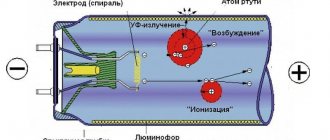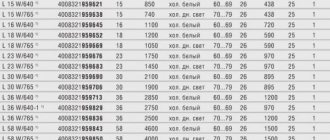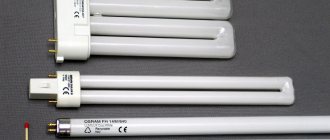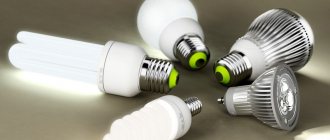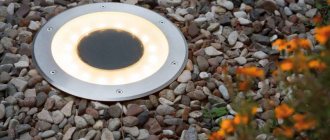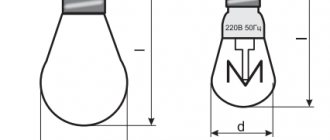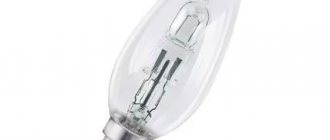Almost every one of us, when choosing lighting for any purpose, has encountered the difficulty of choosing one or another lighting device.
Now there are a great variety of options on the market in this area, each of which has its own positive qualities and, of course, some disadvantages.
However, there are also those manufactured products that have been recognized by the consumer segment for a long time.
These products include fluorescent lamps, which are widely used almost everywhere. Their performance characteristics are noted at the highest level, and the disadvantages can be considered not too significant.
In short, for installing a lighting system this is a fairly optimal option, which is also distinguished by its efficiency.
What are fluorescent lamps and their characteristics
A fluorescent lamp is a fairly common phenomenon in our lives.
Surely each of us has visited some public institutions and noticed the specifics of lighting in these buildings. However, few people know what exactly this product is.
Fluorescent lamps are gas-charging devices that base their operation on the physical impact of an electric discharge in gases.
Such a device contains mercury, which provides ultraviolet radiation, which is converted into light in the lamp itself.
This process occurs with the help of a very important element - phosphor.
The phosphor can be a mixture of any chemical elements, for example, calcium halophosphate with something else.
By selecting any type of phosphor, you can achieve the most interesting effects, for example, changing the color scheme of the lamp light. When choosing a product, you should pay attention to one of the most important indicators - the overall color rendering index. It is designated by a combination of the letters Ra, and the higher the value indicated in the accompanying documentation for the lamp, the better it will perform its job.
Thanks to this lighting system, the fluorescent lamp has become a clear leader over the same incandescent lamps.
And if we take into account that its operational characteristics provide a much longer period of use, then there is no need to think about the correct choice in favor of a fluorescent lamp.
How to properly light a house
Visitors to our site often ask the question of how many fluorescent lamps are needed to illuminate a particular room, and how to correctly position the light sources.
Combination of natural and artificial lighting
Despite the fact that there are clear regulations on this issue, the answer is not so simple. The reason is that we all perceive light differently and must largely rely on our own sensations.
State standards only establish minimum values. They are measured in Lux, the number of which is shown in the following table.
Lighting standards for different types of rooms
1 Lux is 1 Lumen per 1 m2. That is, to get standard lighting in a living room of 15 m2, you need to make the following calculation: 15*150=2250 Lumens. This is the total amount of light that the lamps in the room should produce.
Calculation of lighting level
A 10 W fluorescent lamp produces about 400 Lumens, which means that such a room requires at least 6 such lamps. The instructions are simple, but the calculation is approximate, since you need to additionally take into account the distance from the floor to the lamps and other factors, but it works and is applicable for living rooms.
We recommend increasing the table indicators by at least 1.5 times.
In conclusion, we suggest watching a video story from a famous TV show about fluorescent lamps. Perhaps someone will find additional interesting information for themselves.
Advantages and disadvantages of fluorescent lamps
Like everything around us, fluorescent lamps have their positive and negative sides. Fortunately, there are much fewer of the latter.
As mentioned earlier, fluorescent lamps are the clear leader among lighting means. The superiority over incandescent lamps is not difficult to notice even for the most inexperienced person in electrics.
Advantages
The advantages of this element include the following:
- it produces light output to a much greater extent, and the quality of light is somewhat higher than that of other lighting elements;
- long service life, ensuring no interruptions in operation of the lamps;
- The efficiency of such a product is much higher;
- Diffuse light, which causes less harm to the retina of the eye, which means that when using this lamp you can significantly reduce the risk of vision problems;
- wide range in terms of light colors.
Flaws
Of course, fluorescent lamps also have negative qualities. This list includes the following items:
- The mercury content in such products poses some chemical hazard and requires special disposal;
- The strip spectrum is not distributed evenly, and this may cause some inconvenience in terms of perceiving the real color of objects that are illuminated by a fluorescent lamp; however, a certain reservation should be made here: there are specimens that represent an almost complete continuous spectrum, but the degree of light output in this case decreases;
- The phosphor contained in these lamps performs its work with less efficiency over time, this reduces the efficiency of the lamp and reduces the degree of light output;
- When installing a fluorescent lamp, it is necessary to buy an additional ballast, which will either cost the consumer a fairly large sum, but will have optimal performance, or it will be somewhat cheaper in price, but will provide a high noise level and unreliable operation;
- The power rating is low, therefore, this option is not very suitable for the electrical network. There are also less significant disadvantages, however, their influence does not play a very significant role in the use of fluorescent lamps.
Properties of mercury
All concerns about the use of fluorescent lighting did not arise out of nowhere. After all, the production of lamps uses a small amount of mercury vapor, which is poisonous to humans, according to most. Understanding the meaning of this stereotype will allow knowledge about the properties of this only naturally liquid metal.
From chemistry course we know that at room temperature mercury is in a liquid state. In itself, this heavy silver metal is not dangerous. However, mercury is capable of evaporating even at such a low temperature, not to mention its more serious values. These vapors are capable of not only independently distributing through the air indoors, but also forming volatile compounds with organic substances and being absorbed on household items, furniture, and even ordinary dust particles.
Drops of mercury in a test tube
Vapors can penetrate building materials, water and soil. Liquid mercury has a low viscosity and high surface tension, which helps to separate one drop into many smaller ones. This further increases the evaporation area. Liquid mercury particles are very mobile, which makes demercurization of the room very difficult. They dissolve easily in organic solvents and even in water in the absence of free oxygen. At pH = 8, solubility is at a minimum. When this indicator changes in any direction, the solubility increases. Liquid mercury can easily dissolve some metals, even noble ones. In this case, so-called amalgams are formed. In this regard, it is natural that this substance has a destructive effect on metal structural materials.
The chemical properties of mercury are such that it is very highly ionized, and this creates great difficulties in converting its vapors into relatively safe salts. At room temperature, its oxidation in air is impossible. Very strong oxidizing agents are needed. Even dilute acids, such as sulfuric and hydrochloric, are not suitable. Concentrated nitric acid or aqua regia is required for the mercury oxidation reaction to take place. It is the difficulty of neutralizing this toxic substance that necessitates the need to take serious safety measures when using mercury in various devices, including fluorescent lamps.
Classification and typology of fluorescent lamps
Naturally, progress in the production of products such as fluorescent lamps does not stand still, and if previously mostly similar units with similar technical characteristics were used, today the consumer can choose the option that will be the most optimal and effective for him.
There are many signs by which these lamps can be classified, but nevertheless, the most basic one, nevertheless, will be the sign of pressure indicators.
At the moment, gas-charged mercury specimens of high and low pressure are available on the market.
High pressure lamps have found their use mainly in outdoor lighting. Since such products have high power, their light inside the building will be quite unpleasant for the eye to perceive.
Also, high-pressure lamps are excellent for assembling any lighting installations.
Low pressure lamps have comparatively lower power, which means they are suitable for use inside buildings.
The purpose of the room can be absolutely any: fluorescent lamps of this indicator are suitable for workshops and industrial buildings, and for residential premises.
In addition to dividing lamps according to the principle of pressure, there is also a classification according to the diameter of the tube or bulb of the lamp , as well as according to the ignition pattern.
For example, you can take products from the most famous manufacturers, for example, Osram and Philips. If you look closely at the data on the packaging, you can see a letter and a number next to each other. These are the product type markings.
So, fluorescent lamps are divided into :
- T5 - lamps with this indicator are a rather rare phenomenon that has not found recognition among the consumer segment. Their cost is quite high, but the degree of light output shows excellent results - up to 110 lm/watt. It is worth noting that now manufacturers have significantly increased the production volume of fluorescent lamps with this indicator.
- T8 is a new product that has a fairly high price and is designed for a load of no more than 0.260 A.
- T10 is an analogue of lamps labeled T12, characterized by a rather low quality and level of efficiency.
- T12 is the market leader in fluorescent lamps . It includes a wide variety of subtypes, what can I say, almost all standard models belong to this group. Their number includes representatives of almost all fluorescent lamp manufacturers.
The above-mentioned principle of classification according to the ignition circuit has two types: those requiring a starter and those not requiring it.
Power is also a fairly significant characteristic of fluorescent lamps; accordingly, this also became a factor for identifying a separate classification.
According to power indicators, lamps are divided into:
- Standard – marked T12;
- HO - high power lamps, however, have a comparatively lower light output;
- VHO - lamps that can withstand a load of up to 1.5 A;
- "Economy" - options for fluorescent lamps.
The criteria by which lamps can be divided into groups include length.
There are a great many options for this differentiation. As a rule, manufacturers are required to indicate this data in the instructions or on the packaging.
Classification by starter use
It is also worth noting the fact that fluorescent lamps can be divided into types and according to the type of connection.
You can read more about how to connect fluorescent lamps in various ways in this article.
However, in this case, it is quite difficult to identify any exact categories, since each type, distinguished, for example, by power or the need for the presence of a starter, requires compliance with its own nuances.
Conclusion
So, in this article we reviewed the most basic information about such a benefit of modern technology as fluorescent lamps.
Compliance with these minimal, but very important requirements will ensure completely trouble-free operation of the lamps and maximum benefit from their use.
Did you like the article?
Subscribe to site updates via RSS, or follow updates on VKontakte, Odnoklassniki, Facebook, Twitter or Google Plus.
Subscribe to updates by E-Mail:
If you find an inaccuracy or have a question, please write in the comment form below:
Where are fluorescent lamps used?
As mentioned earlier, fluorescent lamps are widely used almost everywhere.
Despite some negative aspects of using this product, its advantages are still quite difficult to overestimate.
Each of us went to school, visited health care institutions, administrative buildings, etc.
So the lighting system in these rooms is based on the use of fluorescent lamps.
As a rule, these are quite large-scale tubes that provide high-quality lighting in buildings with some architectural features.
But if public buildings are distinguished by their dimensions, for example, high ceilings, large halls and rooms where fairly powerful and constant lighting is required, then at home fluorescent lamps, which will be optimally used there, will not be suitable.
Fortunately, the level of manufacturing skills has increased significantly, which means fluorescent lamps adapted for home conditions have appeared.
They are much smaller in size and contain electronic ballasts that can be connected to sockets used in home electronics.
And despite the freshness of this innovation, adapted lamps are already firmly conquering this market segment.
By the way, there is a rather interesting fact. The already familiar plasma TVs have fluorescent lamps in their mechanism!
Of course, this is also an option adapted in accordance with the specific application, but, nevertheless, the principle of its operation lies in the same phenomenon. Liquid crystal screens, by the way, were previously produced only using fluorescent lamps, but later they were replaced by LEDs.
We have all seen illuminated advertisements on the streets of the city. She also could not do without the use of a fluorescent lamp! Building facades are also illuminated with this product.
Although at the moment, SMD and DIP screens compete with fluorescent lamps in the field of illuminated advertising.
Also, fluorescent lamps are widely used in the field of crop production for growing plants.
Generally speaking, highlighting the main idea of using a fluorescent lamp, we can conclude: it makes sense to use them in cases where it is necessary to supply large rooms with light.
Working together with digital lighting interface systems with the ability to address allows you to ensure high light output and, at the same time, not spend large sums on electricity bills, because compared to incandescent lamps, fluorescent lamps can reduce energy consumption by more than half ! Thus, being energy saving.
In addition, the lamps reduce costs and the duration of their use.
Possible breakdowns
There are several common reasons why fluorescent devices malfunction:
- Triggering of the protective mechanism. This happens due to a short circuit in the electrical network (behind the machine) or a malfunction of the capacitor at the input. This problem is especially common when replacing fluorescent lamps with LED lamps. The problem is corrected by replacing the capacitor. The contacts of the cartridges and the starter should also be tested for working condition. Light bulbs may need to be replaced.
- The light doesn't turn on. The reason is insufficient voltage in the cartridge or its complete absence. The voltage is checked using an indicator screwdriver or a multitester. If the device does not turn on, but there is light at the ends of the tube, the starter is broken. In this case, the starter should be replaced. The absence of a glow indicates a malfunction of the throttle, starter or the lamp itself. If only one end lights up, there is an error in the circuit and needs to be double-checked.
- Continuous flickering. The problem occurs when the starter fails or when there is insufficient voltage in the electrical network. You also need to check the connection diagram - there is probably an error.
- Regular turning on and off of the light bulb indicates its failure. The lamp will need to be replaced.
Network connection
Electronic ballasts for fluorescent lamps
Gas-discharge lamps cannot be directly connected to the electrical network, this is due to the high resistance in the cold state and negative differential resistance.
These problems can be corrected by using ballasts. The most common are EMPA (electromagnetic ballast) and electronic ballast (electronic).
The electronic ballast is an electromagnetic choke that is connected in series with the lamp. A starter is connected in series with the filament coils, which is a neon lamp with bimetallic electrodes and a capacitor. Advantages: simplicity of design, reliability, durability. Disadvantages: long startup time, large amount of electricity required, hum during operation, flickering, large size.
Electronic ballasts supply the light bulb with high-frequency voltage, which eliminates flickering. Uses two options for starting lamps:
- Cold. The lamp turns on immediately after voltage is applied.
- Hot. The electrodes warm up and the source lights up after 0.5-1 second.
The advantages include long service life, lower energy consumption, dimming on some models, and quietness.
Instead of an epilogue
Fluorescent light sources are the best solution for lighting apartments and public places. Since their appearance, the demand for LED light sources has decreased somewhat. Fluorescent lamps are the most suitable option for use in workplaces, classrooms and other areas where strict lighting requirements are imposed and high reliability of lighting devices is important. We must remember that their use will be effective if you choose the right lamps for the lamps and the features of the place to be illuminated.
Lighting calculation
Calculation of natural light
Calculation of natural lighting with side lighting comes down to determining the total area of the windows. (4.10)
where SP – floor area, m2; eН – normalized value of KEO, %; η0 – light characteristics of windows; KZD – coefficient that takes into account the shading of windows by neighboring buildings; τ0 – total light transmittance of the window opening, taking into account shading; r1 – coefficient taking into account the reflection of light from the internal surfaces of the room.
With side lighting, the total light transmittance is determined by formula (4.11):
where τ1 is the light transmittance of the material; τ2 – coefficient taking into account light loss in the frames of the light opening; τ3 – coefficient taking into account light losses in supporting structures; τ4 – coefficient taking into account light loss in sun protection devices.
To determine the coefficient r1, it is necessary to calculate the weighted average reflectance of the walls, ceiling and floor using formula (4.12):
where ρST, ρPT, ρП – reflection coefficients of walls, ceiling and floor, respectively, SST, SPT, SP – areas of walls, ceiling and floor, respectively, m2.
The KZD coefficient is selected from the tables depending on the ratio of the distance (LZD) between neighboring buildings to the height (HZD) of the location of the eaves of the opposing building above the window sill of the window in question:
When designing natural lighting, in addition to the required window area, it should also be taken into account that according to SNiP 23-02-2003 “Thermal protection of buildings” in residential buildings the façade glazing coefficient should be no more than 18%, and in public buildings - no more than 25%.
LL marking
Marking of fluorescent lamps
There are two types of lamp markings that differ from each other: domestic and foreign.
The Russian designation consists of a set of letters and numbers. The definition of decryption is as follows:
- The first letter L stands for lamp.
- The second letter indicates the luminous flux characteristic. D - daylight, CHB - cool white, TB - warm white, EB - natural, B - white, UV - ultraviolet, C - blue, K - red, G - green, G - blue, F - yellow.
- The third sign is the quality of color reproduction. Ts - increased, CC - best.
- The fourth character represents the structure. A - amalgam, K - ring, P - reflex, B - quick start, U - U-shaped.
- The last numbers are power in watts.
The lamp may also contain the abbreviation LHE or LE. It denotes natural or cool natural light.
Foreign markings consist of a three-digit number and a signature in English like cool white (cold light). You can find the designations in the tables.
